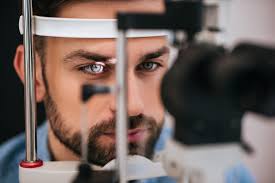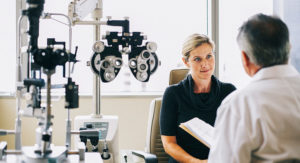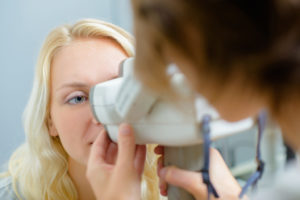
While diabetic eye disease most often refers to diabetic retinopathy, the term may be used to describe any of several eye problems caused by diabetes. Because diabetics are at an increased risk of developing vision problems, it is important that all diabetics regularly see an optometrist. Continue reading below for more information on the various types of diabetic eye disease.

Some of the content below has been provided by Dr. Cheryl Stoker, OD, and is medically reviewed for accuracy. Dr. Stoker is an excellent resource for information about diabetic eye care and health as she is herself a diabetic. Therefore, Dr. Stoker has a unique and experienced perspective for an eye care professional working with diabetics on maintaining their health. Some links have been added to audio transcripts to provide access to relevant resources or information.
Table of Contents:
- What are the types of diabetic eye disease?
- How is diabetic retinopathy (including macular edema) treated?
- Is diabetic eye disease treated differently if you have type 1 versus type 2 diabetes?
- What other eye problems affect diabetics?
- How can I decrease my risk for diabetic eye diseases?
- Advice and tips for diabetics about eye health and overall health from Dr. Stoker
Whether you need regular exams to monitor for diabetic retinopathy or if you have already been diagnosed, the experts here at Louisiana Eye & Laser are here to help! Contact us below or continue reading for more information.

What are the types of diabetic eye disease?
Answer provided by Dr. Cheryl Stoker. Transcript included below.
Dr. Cheryl Stoker, OD:
Okay. The types of diabetic eye disease… Well, diabetes for one thing affects the eyes in many different ways. Blood sugar levels fluctuate and when they’re high, it causes the vision to be blurry, and when the blood sugar comes back down, then the vision can clear up. So with diabetics, typically they can have fluctuating vision as their blood sugar fluctuates.
There’s two different types of diabetes as well. There’s type 1 and there’s type 2, and both of these increase the risk of getting premature cataracts, also increase the risk of glaucoma, which is due to an increase in pressure in the eye which can actually lead to blindness by affecting the optic nerve in the back of the eye. They can also affect diabetic retinopathy and macular edema, and diabetic retinopathy has two forms. This is what we look for in an eye exam because these are very, very important things to observe early, because the earlier we can observe these, the sooner we can treat them.
There’s two forms. There’s non proliferative diabetic retinopathy and proliferative diabetic retinopathy. So I’ll talk about non proliferative diabetic retinopathy first because it is the beginning stage when blood vessels in the retina can swell and leak which causes hemorrhaging and can cause swelling in the retina and macula. The macula is the area, it’s in the central part of our retina that gives us our central vision, so it’s a very important part of the eye.
Then there’s proliferative diabetic retinopathy, which is the advanced stage where fragile new blood vessels grow and leak into the vitreous, which is the jelly-like substance found in front of the retina, and this leaking can cause vitreal floaters due to hemorrhaging. Floaters are actually blood that leaks out into the vitreous and causes hemorrhaging. There’s also macular edema during this stage of diabetic retinopathy which affects our vision because the macula is where we get our central vision. One thing people don’t realize I don’t think is that diabetes is one of the leading causes of blindness, so it’s very, very important to be able to determine if there are any of these manifestations in the eye as diabetes.
[End of Dr. Stoker Audio Transcript]
Additional information about diabetic eye diseases
Diabetic eye disease is an umbrella term, typically used to refer to one of the following eye problems stemming from diabetes:
Diabetic Retinopathy is the leading cause of blindness in American adults, affecting nearly half of all diabetics. Diabetic retinopathy occurs when high blood sugar levels damage blood vessels in the retina. While there is no cure for diabetic retinopathy, it can be managed.
There are two forms of diabetic retinopathy: non proliferative diabetic retinopathy (NPDR) and proliferative diabetic retinopathy (PDR). NPDR (early stage diabetic retinopathy) often has little or no symptoms, although patients’ vision may ultimately become blurry. PDR (late stage diabetic retinopathy) has a variety of symptoms, which typically affect both eyes and can include:
- Floaters
- Blurred vision
- Blank or dark spots in your vision
- Poor night vision
- Colors appearing faded
Diabetic macular edema actually stems from diabetic retinopathy. Macular edema is caused by fluid building up on the retina, leading to swelling and blurry vision. Macular edema can even cause permanent loss of vision if it is not treated. As with diabetic retinopathy, patients may not experience symptoms at first, making it crucial for all diabetics to regularly receive dilated eye exams.
Cataracts can also be caused by excess blood sugar from diabetes. A cataract is an opacification of the eye’s natural lens, which can lead to blurred vision, glare and difficulty reading. Cataracts are typically painless and progress fairly slowly. Unfortunately, it is impossible to stop this progression and surgery is currently the only proven form of treatment for cataracts. Monitoring blood sugar levels and following a primary care physician’s diet and exercise recommendations may help reduce the risk of cataracts in diabetics.
Glaucoma can refer to any of several eye conditions that damage the optic nerve and ultimately cause blindness. Fortunately, glaucoma can be treated and the remaining vision can be salvaged if it is caught early on. Diabetes significantly increases an individual’s risk for glaucoma. While symptoms such as blurred vision, headaches, nausea, red eyes or halos may occur, many patients often do not experience symptoms in the early stages of glaucoma.

How is diabetic retinopathy (including macular edema) treated?
Answer provided by Dr. Cheryl Stoker. Transcript included below.
Dr. Cheryl Stoker, OD:
Okay. There’s many different ways depending on how extensive the hemorrhaging and the leaking of the blood vessels are in the retina. When there’s extensive leaking of the blood vessels, a specialist will use a laser to basically cauterize the bleeding in the retina to stop it. However, by doing this, it leaves little scars on the back of the retina which can actually affect the vision, so it’s best to try to prevent this from happening in the first place. But also the laser surgery can be used to treat macular edema, although the problem with that is it leaves scars in the macula which is where we get our central vision, so that will definitely affect our vision going forward.
There’s also what we call intravitreal injection therapy, which is used to treat macular edema as well. There’s two drugs that they use for this, steroids and what they call anti-VEGF agents, that have been shown to reduce macular edema. Anti-VEGF drugs target the specific chemicals in the eye. These are called vascular endothelial growth factor, which you don’t have to memorize anything, but those are VEGF, and this is critical in causing abnormal blood vessels to grow under the retina.
So several drugs have been developed to block this trouble causing VEGF. They’re called anti-VEGF drugs, and they’re actually injected into the eye itself and they help treat macular edema by reducing the growth of the abnormal blood cells and slowing the hemorrhaging or the leakage which helps slow down the vision loss, because like I said before, diabetes is one of the leading causes of blindness, and part of that is because of the macular edema. The VEGF drugs are done by injecting them directly into the eye.
[End of Dr. Stoker Audio Transcript]
Additional information about diabetic retinopathy treatment
While there is no cure for diabetic retinopathy, it can be managed. In the early stages, progression of the disease can be slowed substantially. However, it is not possible to reverse vision loss caused by diabetic retinopathy.
Your doctor may choose a procedure called laser photocoagulation to seal leaking blood vessels and prevent new blood vessel growth. Sometimes medicated eye drops, pills or injections may be the best treatment method. In more serious cases, a vitrectomy may be necessary. A vitrectomy removes the gel-like vitreous humor that has been damaged by leaking blood vessels and replaces it with a clear fluid. This procedure can restore vision that has been lost to a diabetic vitreous hemorrhage.
![]()
Is diabetic eye disease treated differently if you have type 1 versus type 2 diabetes?
Answer provided by Dr. Cheryl Stoker. Transcript included below.
Dr. Cheryl Stoker, OD:
Not necessarily. The thing is with type 1 diabetes, they tend to be more at risk for diabetic retinopathy because for one thing, they’re diagnosed at a much younger age and their diabetes is typically worse, so they are usually on insulin, because type 2 diabetics aren’t always put on insulin, but type 1 are always put on insulin because they have to have that to control their blood sugar. So type 1 diabetics are definitely more at risk for diabetic retinopathy.

Are there other eye problems that affect diabetics?
Answer provided by Dr. Cheryl Stoker. Transcript included below.
Dr. Cheryl Stoker, OD:
Diabetes can cause other problems such as blurring vision because of the fluctuations in the blood sugar and cataracts. Everyone develops cataracts at some point, but diabetics typically have them earlier than they normally would if they weren’t diabetic, so cataracts tend to form sooner and the patient usually needs to have them removed sooner than people who are not diabetic. It can also cause glaucoma, which is due to an increase in pressure in the eye which can put pressure on the optic nerve in the back of the eye which can lead to blindness, because once that optic nerve is damaged, it’s irreversible, so that’s another serious complication.
People who are diabetic tend to have dry eyes, and dry eyes has become a really serious problem because it can affect so many other aspects of your life, not just your vision because it causes blurry vision, but it can be painful and you require usually artificial tears or something like that. But diabetics tend to have dry eye disease as well, and then, of course, diabetic retinopathy. But also people who are diabetic tend to have hypertension, which also affects the blood vessels in the back of the eye. Anything that affects blood vessels in the body affects the eye because the back of the eye is typically made out of a lot of blood vessels, so it’s important for diabetics too if they do have hypertension to be sure and take their medicine and keep that under control as well because that can affect the eye as well.

How can I decrease my risk for diabetic eye diseases?
Answer provided by Dr. Cheryl Stoker. Transcript included below.
Dr. Cheryl Stoker, OD:
The main thing is to keep your blood sugar under control, and that sounds like an easy thing to say, but I know it’s not easy because I’m diabetic myself and I know how hard it is. It’s very difficult. It’s one of the hardest things I’ve ever had to do and I’m not always perfect, but it’s so important because diabetic retinopathy, like I said before, is one of the leading causes of blindness. So one of the main things is to keep the blood sugar under control. Also getting a regular eye exam is imperative when you’re diagnosed with diabetes because as an optometrist, I do diabetic eye exams on a daily basis. It’s very important because if we can detect signs of diabetic retinopathy early, then it could be treated early because when I discussed the laser therapy, the more laser you have done in the eye, the more scarring there is, and that can affect your vision. So if we can catch these things early, we can preserve vision better if it’s caught early, so that’s why it’s recommended to have an eye exam at least once a year at a minimum when you’re diabetic, and some diabetic specialists recommend even every six months to have a full dilated eye exam.

Advice and tips for diabetic eye care and overall health
Answer provided by Dr. Cheryl Stoker. Transcript included below.
Dr. Cheryl Stoker, OD:
So what I’d like for people to take away from this is the importance of keeping diabetes under control, and it’s basically your blood sugar, and it’s done by taking your medication that is prescribed by a doctor because that’s what’s going to help it stay under control. But just as important is diet, and a lot of diabetics I’ve come across aren’t sure of what the foods they’re supposed to be eating and what they’re not supposed to be eating.
A lot of diabetics think that just by avoiding sugar and sweets that that’s all they need to do, and that’s really not the case because there are other things like carbohydrates that also affect blood sugar dramatically. The list of those would be things like white bread, white rice, pasta, potatoes. Things like that should be avoided. There’s lots of fruits too that should be avoided because they make your blood sugar levels go up. But berries are good for diabetics, like blueberries, strawberries, raspberries, things like that. Those are really good for diabetics. Lean meats and fish are also good as well as vegetables, and lots of vegetables are the best thing. Fats should also be limited, because it amazes me how many diabetics do not realize what their diet is supposed to look like.
It’s also very important to test their blood sugar every day. I have a lot of diabetic patients that don’t do this and so I ask them, “Is your diabetes under control?” and they say yes, and I say, “Well, do you test every day?” and they said no, and I said, “Well, then you don’t know if it’s under control or not,” because that reading that you get first thing in the morning before you eat anything that’s called the fasting sugar really gives you the most information about whether your blood sugar is under control or not. So that’s real important to do every day.
Also it’s important for diabetics to know their A1C. Their A1C is a number that you go to the doctor and they do blood work, and they test your blood sugars for the previous three months, and that tells you if it’s under control or not. The numbers should be anywhere from six to seven. It amazes me that so many diabetics don’t know their A1C and they don’t even know what that is, but it’s a very, very important number that every diabetic should know what their number is because that lets them know if it is under control or not.
As I said before, I’m diabetic myself and I know how hard it is, and I try and stay on my diet, but it’s important to try because you can’t always. It’s okay to go off of it occasionally, but we should try and stay on it at least 90% of the time, because I know how hard it is, but diabetic retinopathy, the consequences of that are even worse. When I think about eating something that I’m not supposed to eat, I think about that. I think, “Do I want to lose my vision for this piece of cake?” or whatever, and then I’d say, “No. My vision is more important,” so that’s what you’d have to do. It’s not fun, but it’s necessary.
It’s also imperative to have a yearly eye exam, not just test your blood sugar and watch your diet, but see your doctor regularly, your medical doctor, and to have your eyes examined at least once a year.

Visit Louisiana Eye & Laser for diabetic eye care
All diabetics should receive a yearly dilated eye exam to check for diabetic retinopathy, regardless of whether or not they have symptoms. Over the years, the experts at Louisiana Eye & Laser have diagnosed and helped manage diabetic eye diseases in countless patients. Whether it has been a year since your last exam or if you believe you are experiencing symptoms, our highly-trained staff is here to help! Simply call, go online or stop by one of our offices to schedule an eye exam.




